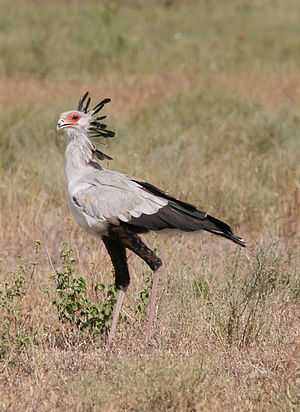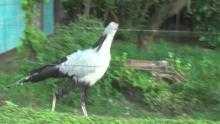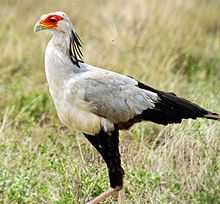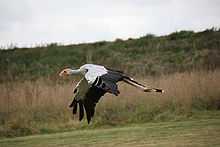Secretarybird
| Secretarybird | |
|---|---|
 | |
| In Serengeti National Park | |
| Conservation status | |
| Scientific classification | |
| Kingdom: | Animalia |
| Phylum: | Chordata |
| Class: | Aves |
| Order: | Accipitriformes |
| Family: | Sagittariidae (R. Grandori & L. Grandori, 1935) |
| Genus: | Sagittarius Hermann, 1783 |
| Species: | S. serpentarius |
| Binomial name | |
| Sagittarius serpentarius (J. F. Miller, 1779) http://www.birdlife.org/datazone/speciesfactsheet.php?id=3562 | |

The Secretarybird or Secretary Bird (Sagittarius serpentarius) is a very large, mostly terrestrial bird of prey. Endemic to Africa, it is usually found in the open grasslands and savannah of the sub-Saharan region. Although a member of the order Accipitriformes, which also includes many other diurnal raptors such as kites, buzzards, vultures, and harriers, it is given its own family, Sagittariidae.
It appears on the coats of arms of Sudan and South Africa.
Taxonomy
First described by English illustrator John Frederick Miller in 1779,[2] the Secretarybird was soon assigned to its own genus, Sagittarius, by French naturalist Johann Hermann in his Tabula Affinatum Animalium.[3] It was not until 1935 that the species was moved to its own family, distinct from all other birds of prey—a classification confirmed by molecular systematics.[4] Recent cladistic analysis has shown Sagittariidae to be an older branch of the diurnal birds of prey than Accipitridae and Falconidae, but a younger divergence than Cathartidae.[5] Sometimes, the enigmatic bird Eremopezus is classified as an early relative of the Secretarybird, though this is quite uncertain as the bird is only known from a few fragmentary body parts such as the legs. The earliest fossils associated with the family are two species from the genus Pelargopappus. The two species, from the Oligocene and Miocene respectively, were not discovered in Africa but France. The feet in these fossils are more like those of the Accipitridae; it is suggested that these characteristics are primitive features within the family. In spite of their age, it is not thought that the two species are ancestral to the Secretarybird.[6]
Its common name is popularly thought to derive from the crest of long quill-like feathers, lending the bird the appearance of a secretary with quill pens tucked behind his or her ear, as was once common practice. A more recent hypothesis is that "secretary" is borrowed from a French corruption of the Arabic saqr-et-tair or "hunter-bird."[7]
The generic name "Sagittarius" is Latin for "archer," perhaps likening the Secretarybird's "quills" to a quiver of arrows, and the specific epithet "serpentarius" recalls the bird's skill as a hunter of reptiles.[8] Alternatively, the name could refer to the last two constellations in the Zodiac, Sagittarius and Serpentarius (now known as Ophiuchus).[citation needed]
Biology
Description

The Secretarybird is instantly recognizable as having an eagle-like body on crane-like legs which increases the bird’s height to as much as 1.3 m (4 ft) tall. This bird has an eagle-like head with a hooked bill, but has rounded wings.[9] Body weight can range from 2.3 to 4.5 kg (5.1 to 9.9 lb) and height is 90–130 cm (35–51 in). Total length from 112 to 152 cm (44 to 60 in) and the wingspan is 191–220 cm (75–87 in).[10][11][12] The tarsus of the secretarybird averages 31 cm (12 in) and the tail is 57–85 cm (22–33 in), both of which factor into making them both taller and longer than any other species of raptor.[10] The neck is not especially long, and can only be lowered down to the inter-tarsal joint, so birds reaching down to the ground or drinking must stoop to do so.[7]
From a distance or in flight it resembles a crane more than a bird of prey. The tail has two elongated central feathers that extend beyond the feet during flight, as well as long flat plumage creating a posterior crest.[9] Secretarybird flight feathers and thighs are black, while most of the coverts are grey with some being white.[13] Sexes look similar to one another as the species exhibits very little sexual dimorphism, although the male has longer head plumes and tail feathers. Adults have a featherless red face as opposed to the yellow facial skin of the young.[9]
Habitat
Secretarybirds are endemic to Sub-Saharan Africa and are non-migratory, though they may follow food sources.[14] Their range extends from Mauritania to Somalia and south to the Cape of Good Hope.[9] These birds are also found at a variety of elevations, from the coastal plains to the highlands. Secretarybirds prefer open grasslands and savannas rather than forests and dense shrubbery which may impede their cursorial existence.[15] While the birds roost on the local Acacia trees at night, they spend much of the day on the ground, returning to roosting sites just before dark.[16]
Diet

Unlike most birds of prey, the Secretarybird is largely terrestrial, hunting its prey on foot. Adults hunt in pairs and sometimes as loose familial flocks, stalking through the habitat with long strides.[17] Prey may consist of insects, mammals ranging in size from mice to hares and mongoose, crabs, lizards, snakes, tortoises, young birds, bird eggs, and sometimes dead animals killed in grass or bush fires. Larger herbivores are not generally hunted, although there are some reports of Secretarybirds killing young gazelles.[17] The importance of snakes in the diet has been exaggerated in the past, although they can be locally important and venomous species such as adders and cobras are regularly among the types of snake preyed upon.[18]

Prey is often discovered by the Secretarybirds via stomping on clumps of vegetation, which then flushes prey for them to capture. It also waits near fires, eating anything it can that is trying to escape. They can either catch prey by chasing it and striking with the bill and swallowing (usually with small prey), or stamping on prey until it is rendered stunned or unconscious enough to swallow.[9] Studies of this latter strategy have helped reconstruct the possible feeding mechanisms employed by the gigantic 'terror birds' that lived between sixty and five million years ago.[19] Larger or dangerous prey, such as venomous snakes, are instead stunned or killed by the bird jumping onto their backs, at which point they will try to snap their necks or backs. There are some reports that, when capturing snakes, the Secretarybirds will take flight with their prey and then drop them to their death, although this has not been verified. Even with larger prey, food is generally swallowed whole through the birds' considerable gape. Occasionally, like other raptors, they will tear apart prey with their feet before consuming it.[18]
Young are fed liquefied and regurgitated insects directly by the male or female parent and are eventually weaned to small mammals and reptile fragments regurgitated onto the nest itself. The above foodstuffs are originally stored in the crop of the adults.[9]
In hunting and feeding on small animals and arthropods on the ground and in tall grass or scrub, Secretary Birds occupy an ecological niche similar to that occupied by peafowl in South and Southeast Asia, roadrunners in North and Central America and seriemas in South America.[citation needed]
Reproduction
Mating

Secretarybirds associate in monogamous pairs. During courtship, they exhibit a nuptial display by soaring high with undulating flight patterns and calling with guttural croaking. Males and females can also perform a grounded display by chasing each other with their wings up and back, much like the way they chase prey. They usually mate on the ground, although some do so in Acacia trees. Secretarybirds will stay close to their mate even if their chick has already left.
Rearing
Nests are built at a height of 5–7 m (15–20 feet) on Acacia trees. Both the male and female visit the nest site for almost half a year before egg laying takes place. The nest is around 2.5 m (eight feet) wide and 30 cm (one foot) deep, and is constructed as a relatively flat basin of sticks.
Secretarybirds lay two to three oval, pale-green eggs over the course of two to three days, although the third egg is most often unfertilised.[citation needed] These eggs are incubated primarily by the female for 45 days until they hatch. The Secretarybirds are facultatively fratricidal.[20] There are conflicting opinions on this phenomenon also called cainism—"No evidence [exist] of sibling aggression, but youngest in brood of 3 almost always dies of starvation..."[21]
The downy young can feed autonomously after 40 days, although the parents still feed the young after that time. Both the parents feed the young. At 60 days, the young start to flap their wings, and by day 65–80 are able to fledge. Fledging is accomplished by jumping out of the nest or using a semi-controlled fall via fervent wing flapping to the ground. After this time, the young are quickly taught how to hunt through expeditions with their parents and are considered independent soon after.[9]
Relationship with humans
Cultural significance

The Secretarybird has traditionally been admired in Africa for its striking appearance and ability to deal with pests and snakes. Africans sometimes call it the Devil's Horse. As such it has often not been disturbed, although this is changing as traditional observances have declined.[7]
The Secretarybird is the national emblem of Sudan as well as a prominent feature on the Coat of arms of South Africa.
In Sudan, it is featured in the middle white strip of the Presidential Flag; it is the main object on the Presidential Seal, and features heavily in Sudanese military insignia. The Secretarybird on the Presidential Flag and Seal has its head turned to the right, with its distinctive crest clearly visible and its wings spread out with a white banner between its outstretched wings reading "Victory is Ours".
The Secretarybird has been a common motif for African countries on postage stamps, over 65 stamps from about 30 countries are known as of date including some from stamp-issuing entities such as Ajman, Manama. the Maldives and the United Nations where the bird does not occur.[22]
Threats
The young are preyed upon by crows, ravens, hornbills, large owls and kites as they are vulnerable in Acacia tree tops, with no known incidents of predation on adults.[9][18] As a population, the Secretarybird is mainly threatened by loss of habitat and deforestation.[23] In 1968 the species became protected under the Africa Convention on the Conservation of Nature and Natural Resources.[9] Nevertheless the species is still widespread across Africa, and has adapted well to arable land where prey animals such as rodents are more common than in traditional habitat. The species is well represented in protected areas as well. That is what makes them endangered.
There is some anecdotal evidence that secretarybirds can be aggressive towards humans sometimes, and there are reports of them killing humans.[citation needed]
References
- ↑ BirdLife International (2013). "Sagittarius serpentarius". IUCN Red List of Threatened Species. Version 2013.2. International Union for Conservation of Nature. Retrieved 26 November 2013.
- ↑ Miller, John Frederick (1779). Icones Animalium et Plantarum (in Latin). pt 5 pl. 28.
- ↑ Hermann, Johann (1783). Tabula affinitatum animalium olim academico specimine edita, nunc uberiore commentario illustrata cum annotationibus ad historiam naturalem animalium augendam facientibus (in Latin). Strasbourg: Argentorati. pp. 2, 370.
- ↑ Wink, Michael; Seibold, I.; Lotfikhah, F. & Bednarek, W. (1998): “Molecular systematics of holarctic raptors (Order Falconiformes)” in Chancellor, R.D., Meyburg, B.-U. & Ferrero, J.J. (eds.): Holarctic Birds of Prey: 29–48. Adenex & WWGBP. (PDF)
- ↑ Mayr, G.; Clarke, J. (2003) "The deep divergences of neornithine birds: a phylogenetic analysis of morphological characters" Cladistics 19 527–553
- ↑ Caley, Kevin (2007), "Fossil Birds", in del Hoyo, Josep; Elliott, Andrew; Christie, David, Handbook of the Birds of the World. Volume 12, Picathartes to Tits and Chickadees, Barcelona: Lynx Edicions, pp. 11–56, ISBN 84-96553-42-6
- ↑ 7.0 7.1 7.2 Kemp, AC (1994) Family Sagittariidae (Secretarybird) in del Hoyo, J.; Elliott A.; Sargatal J. (eds) Handbook of the Birds of the World, Volume 2 Barcelona:Lynx Edicions 206–215
- ↑ Sherman, P.; Rasmussen P.. "Sagittarius serpentarius". Animal Diversity Web. University of Michigan. Retrieved 3 June 2009.
- ↑ 9.0 9.1 9.2 9.3 9.4 9.5 9.6 9.7 9.8 Eagles, Hawks, and Falcons of the World, Volume 2 - Brown, L. & Amadon, D. New York: McGraw-Hill Book Company (1968)
- ↑ 10.0 10.1 Raptors of the World - Ferguson-Lees, J.; Houghton Mifflin, New York. 978-0618127627 (2001)
- ↑ (2011).
- ↑ Burnie D and Wilson DE (Eds.), Animal: The Definitive Visual Guide to the World's Wildlife. DK Adult (2005), ISBN 0789477645
- ↑ Birds of Africa: South of the Sahara - Sinclair, I. & Ryan, P., Princeton and Oxford: Princeton University Press (2003)
- ↑ Bird Migration in Africa: Movements between six continents, Volume 2 - Curry-Lindahl, K., New York: Academic Press (1981)
- ↑ Sinclair, Ian; Hockey, Phil; Tarboton, Warwick (1993). Illustrated Guide to the Birds of Southern Africa. Princeton University Press. ISBN 0-691-09682-1.
- ↑ - Dean, W. R. J.; Milton, S.J.; Jeltsch, F. (1999) "Large trees, fertile islands, and birds in arid savanna" Journal of Arid Environments 41 61–78
- ↑ 17.0 17.1 The Depression of Reptile Biomass by Large Herbivores - Janzen, D.H., American Naturalist, 110, 71-400 (1976)
- ↑ 18.0 18.1 18.2 (2011).
- ↑ Marshall, L.G. (March, 2001) "The Terror Birds of South America" Scientific American 82–89
- ↑ Evolution of Growth Rates in Eagles: Sibling Competition Vs. Energy Considerations - Bortolotti, B.R., Ecology, 67, 182–194. (1986)
- ↑ Hockey PAR, Dean, WRJ, Ryan PG (eds), 2005, Roberts - Birds of Southern Africa, VIIth ed. Cape Town: The Trustees of the John Voelcker Bird Book Fund. p543. ISBN 0-620-34053-3
- ↑ Scharning, Kjell. "Secretary Bird Sagittarius serpentarius". Theme Birds on Stamps. Retrieved 6 June 2009.
- ↑ Allan, D.G.; Harrison, J.A.; Navarro, R.A.; van Wilgen, B.W.; Thompson, M.W.(1997) "The Impact of Commercial Afforestation on Bird Population in Mpumalanga Province, South Africa - Insights from Bird-Atlas Data" Biological Conservation 79 173–185
External links
| Wikimedia Commons has media related to Sagittarius_serpentarius. |
- Secretary Bird videos, photos & sounds on the Internet Bird Collection
- Birdlife Species Factsheet
- Secretarybird on ARKive
- Secretary Bird on postage stamps.
- Species text in The Atlas of Southern African Birds.
| |||||

